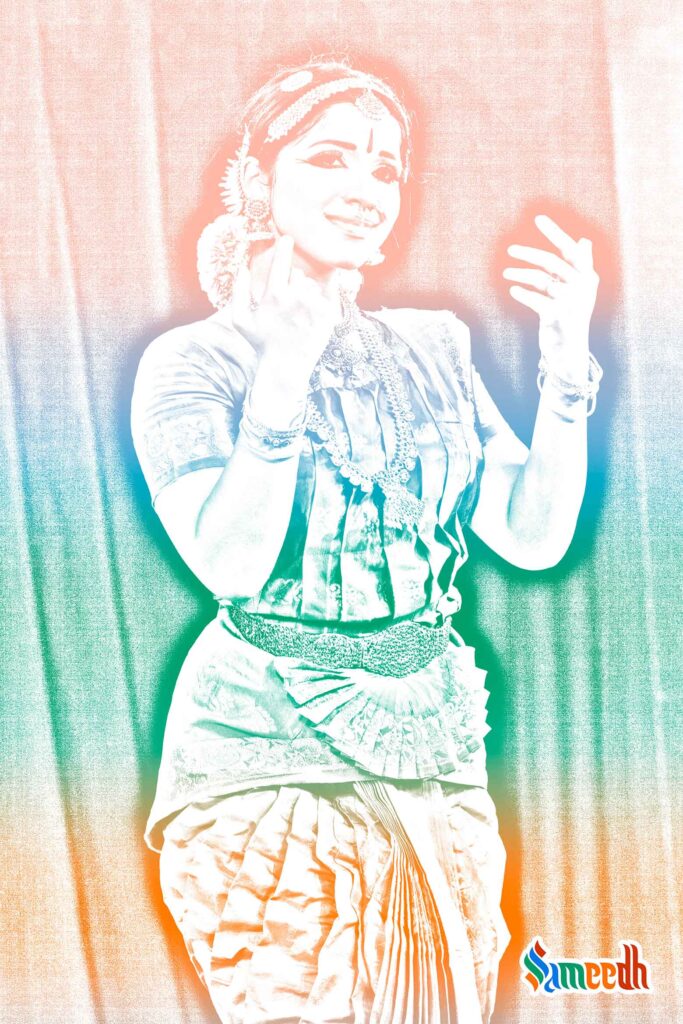Bharatnatyam originated in the state of Tamil Nadu, India. It has its roots in the Natyashastra, which is an ancient text on theatre written by Bharat Muni.

Image Source: Vijay Sundararaman Iyer
Bharatanatyam is a prominent style of dance in Southern India. A well-rehearsed and meticulously orchestrated blend of facial expressions, hand gestures, dance steps, and eye movements are used in a Bharatanatyam performance. Bharatnatyam is regarded to be an extremely elegant display of storytelling and is often highlighted by passionate and powerful dance moves.
SIGNIFICANCE
One of the primary texts used to study the art and nuances of physical movement in Bharatnatyam dance is the ‘Abhinay Darpan’ by Nandikeshwar. Ancient paintings and sculptures made of stone and metal provide several examples of this dance style. A series of Bharatnatyam postures may be found on the walls of the Chidambaram temple, virtually frozen in stone by the craftsman.
ORIGIN AND HISTORY
Bharatnatyam originated in Tamil Nadu’s Hindu temples as a solo dance conducted exclusively by women, and gradually took off in Southern India. Nrita, nritya, and naatya are examples of illustrative tales of religious themes and spiritual ideals of Hinduism that are expressed by dancers with outstanding footwork and attractive gestures. The performance comprises of a vocalist, musicians, and mainly the guru who oversees and directs the event.
As per the history, it is said that Bharat Muni received the sacred dance art of Bharatanatyam from Brahma ji, who later documented it in the Natya Shastra. This text is made up of thousands of poems arranged into several chapters, distinguishing dance into two distinct types: ‘nrita’ which is pure dance made up of delicate hand gestures and motions, and ‘nritya’, which is solo artistic dance composed of expressions.
VARIOUS FORMS OF BHARATNATYAM
Even though the fundamentals of the art form are constant, there are several variations that differ according to the school or style. As Bharatnatyam spread from the South Indian traditional hub of Tanjavur to other regions, other styles, known as Banis, emerged. Over the years, gurus and masters have modified and altered this art form, which resulted in the creation of these various styles.
The Tanjavur style Bani is believed to be the oldest among the other styles that are performed today. The renowned Tanjore Quartette’s immediate ancestors were the masters of this unique style. The renowned Kannuswami Pillai trained Kandappa Pillai, one of the most well-known Nattuvanars or Guru of this technique and a direct ancestor of the Tanjore Quartette.According to history, ‘Baroda’ Kannuswami Pillai managed a group of dancers sent as dowry for the marriage of the Maratha Princess of Tanjavur and the Prince of Baroda.
Mangudi Doirairaja Iyer is credited with developing the Mellatur style. It is renowned for highlighting the shringar ras and for its subtle footwork. The audience can listen to the music and the ghungaroo since dancers in this technique don’t stamp their feet heavily on the floor.
Vazhavur style was developed by Ramiah Pillai, who belonged to Vazhuvur in Tamil Nadu. Vazhavur style places more emphasis on the idea of Lasya than Tandav. This dance style uses more shringar ras and places a larger emphasis on the feminine characteristics of dance. Padma Subramanyam, a well-known performer and student of Ramiah Pillai, is renowned for her realistic abhinay, a vital element of this style.
Rukimini devi is credited with the development of the Kalakshetra style of Bharatnatyam. The Kalakshetra Institution in Chennai was established by Rukmini Devi as a place for the development of Bharatnatyam as a performing art. The emphasis of this distinctive kind of Bharatnatyam is on abhinay.
Pandanallur style emphasises upon precise motions more than the conventional Tanjavur style. The Pandanallur school of Bharatnatyam is renowned for its delicate motions, smooth footwork, and strong emphasis on hand movements.
